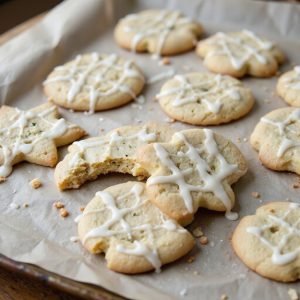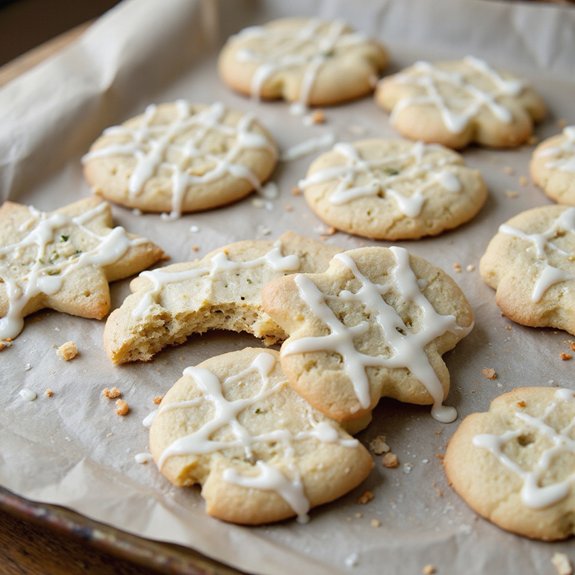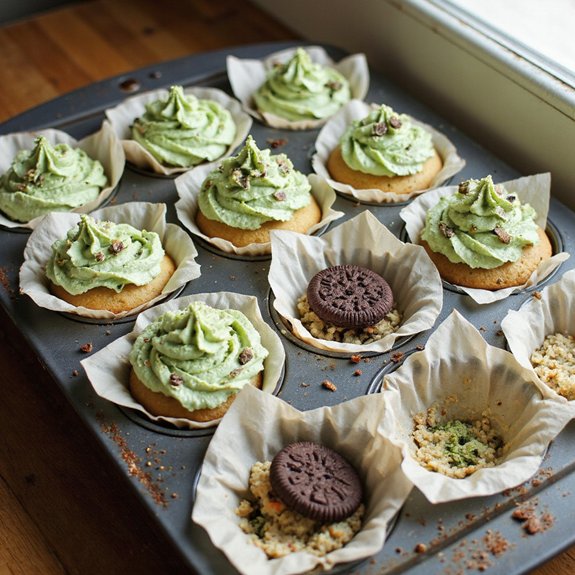Picture a tray of warm, sugar-kissed cookies emerging from the oven—edges pale gold, centers soft and tender, the aroma of vanilla and butter swirling with a creamy note from tangy-sweet cream cheese.
Imagine the slight crackle of sanding sugar, the smooth bite that gives way to a melt-in-your-mouth crumb, and the gentle scent that makes the whole kitchen feel like a hug.
These cookies matter to me because they turn simple afternoons into little celebrations—calming, comforting, and just fancy enough to feel special without the stress.
They’re perfect for busy weeknights when you need a quick treat, Sunday suppers that deserve a sweet finish, or holiday cookie trays that call for clean-cut shapes and dependable dough.
Once, a last-minute bake sale had me scrambling; this dough chilled fast, cut beautifully, and saved the day with glossy, quick icing.
Ready? Let’s cook!
Why You’ll Love It
- Delivers rich, tangy flavor from creamy butter and cream cheese
- Bakes clean-edged shapes perfect for decorating and gifting
- Stays soft and tender with a delicate, melt-in-mouth crumb
- Uses simple pantry staples for easy, reliable results
- Freezes beautifully for make-ahead dough or baked cookies
Ingredients
- 1 cup unsalted butter, softened — room temp for easy creaming (choose high-fat European style)
- 4 oz cream cheese, softened — full-fat block for best texture (avoid whipped tubs)
- 1 cup granulated sugar — superfine dissolves more evenly (look for cane sugar)
- 1 large egg — at room temperature (pasture-raised if possible)
- 1.5 tsp vanilla extract — real vanilla for best flavor (Madagascar preferred)
- 0.5 tsp almond extract, optional — adds bakery-style aroma (use pure, not imitation)
- 3 cups all-purpose flour, spooned and leveled — prevents dense dough (unbleached works well)
- 0.5 tsp baking powder — guarantees slight lift (check freshness date)
- 0.5 tsp fine sea salt — balances sweetness (avoid coarse crystals)
- 2 tbsp all-purpose flour, for rolling — use sparingly to avoid toughness (keep extra on hand)
- 1 cup powdered sugar, for dusting or icing, optional — sift for lump-free icing (10x confectioners’)
- 2–3 tbsp milk, for icing, optional — adjust to thick drizzle (whole milk preferred)
- 1–2 drops food coloring, optional — gel colors give vibrant hues (a little goes far)
- 2 tbsp sanding sugar, optional — sprinkle while icing is wet (choose coarse crystals)
Step-by-Step Method
Cream the Fats
Beat softened butter and cream cheese until perfectly smooth. Use medium speed for about two minutes. Scrape the bowl to remove any lumps. Aim for a silky, unified mixture. Proper creaming guarantees tender cookies.
Avoid overbeating to prevent excess air. Keep ingredients at room temperature for even blending and consistent texture throughout the dough.
Incorporate the Sugar
Add granulated sugar to the creamed mixture. Beat until light and fluffy, one to two minutes. Scrape down the bowl and paddle. Look for a paler color and slightly increased volume. Proper aeration helps cookies hold shape.
Avoid beating too long, which can cause spreading. Maintain a moderate speed for control.
Blend in Egg and Extracts
Beat in the egg, vanilla, and almond extract until fully combined. Mix just until smooth and glossy. Scrape the bowl to catch any streaks. Don’t overmix. Overworking here can toughen the dough.
Guarantee the egg is room temperature for better emulsification. The mixture should be cohesive and fragrant.
Whisk Dry Ingredients
In a separate bowl, whisk flour, baking powder, and fine sea salt. Distribute leavening evenly to prevent pockets. Break up any flour clumps. Keep the mixture light and uniform.
Accurate measuring matters—spoon and level the flour. Properly mixed dry ingredients promote even texture and consistent rise in every cookie.
Combine Wet and Dry
Add dry ingredients to the wet mixture in two additions. Mix on low speed just until no dry streaks remain. Stop as soon as a soft dough forms.
Overmixing develops gluten and creates tough cookies. Scrape and fold with a spatula to finish. The dough should be smooth, soft, and slightly tacky.
Divide and Chill
Split the dough into two equal disks. Wrap each tightly in plastic wrap to prevent drying. Chill until firm, at least two hours or up to two days. Cold dough rolls cleanly and cuts sharp edges. Keep one disk chilled while working the other. Briefly re-chill if the dough softens.
Preheat and Prepare Pans
Heat the oven to 350°F (175°C). Line baking sheets with silicone mats or parchment. Clear space for cooling racks. Organize cutters, extra flour, and a rolling pin. Work efficiently to keep dough cool.
Proper pan preparation prevents sticking and promotes even browning. Avoid greasing, which can cause spread.
Roll the Dough
Lightly flour the surface and rolling pin. Roll one dough disk to 1/4 inch thickness. Rotate and lift frequently to prevent sticking. Add minimal flour to avoid toughness. Roll between parchment for ultra-clean surfaces.
If cracks appear, gently press together. Keep dough cool for crisp edges and defined shapes.
Cut and Transfer
Stamp shapes with cookie cutters, maximizing space between cuts. Re-roll scraps gently once or twice to avoid toughness.
Use a thin spatula to transfer cutouts to lined sheets. Space cookies one inch apart. Chill cut shapes for 10 minutes if soft. Keep shapes uniform for even baking.
Bake to Set
Bake one sheet at a time for 8–10 minutes. Look for set edges and barely pale golden bottoms. Avoid browning for soft cookies. Add one to two minutes for crisper edges. Rotate the sheet halfway if needed.
Remove and cool on the sheet for five minutes to finish setting before moving.
Cool Completely
Transfer cookies to a wire rack after five minutes. Cool fully to room temperature before decorating. Warm cookies melt icing and lose detail. Allow ample airflow around cookies. Handle gently to maintain clean edges.
Prepare icing and decorations while cookies cool for efficient workflow.
Mix a Simple Icing
Whisk powdered sugar with milk to a thick drizzle consistency. Add milk a teaspoon at a time to adjust. Tint with food coloring if desired. Keep icing smooth and lump-free. Test flow on parchment.
Make separate bowls for multiple colors. Cover icing with plastic wrap touching the surface to prevent crusting.
Decorate and Set
Drizzle or spread icing onto cooled cookies. Add sanding sugar immediately while icing is wet. Work in small batches to maintain control. Use piping bags for details or a spoon for quick coverage. Allow icing to dry 30–60 minutes until set to the touch. Store carefully once fully dry.
Store or Freeze
Keep undecorated cookies airtight up to five days. Freeze up to two months with parchment between layers. Let iced cookies dry completely before stacking. Maintain a cool, dry environment to preserve texture.
Refresh with a light dusting of powdered sugar if not icing. Label containers with date and flavor.
Ingredient Swaps
- Butter: use dairy-free/vegan butter sticks 1:1; for budget, use margarine (chill dough well for clean cuts).
- Cream cheese: swap with dairy-free cream cheese 1:1; or 4 oz full-fat Greek yogurt (drain to thicken) for a lighter option.
- Egg: replace with 1 flax egg (1 tbsp ground flax + 3 tbsp water, rested 5 min) or 3 tbsp aquafaba.
- All-purpose flour: gluten-free 1:1 baking blend with xanthan gum; or half AP + half cake flour for extra tenderness.
- Almond extract: omit for nut-free; sub 1/2 tsp extra vanilla or 1/4 tsp lemon extract.
- Sugar: coconut sugar works (dough darker, caramel flavor); for less spread, keep granulated.
- Icing: use plant milk for dairy-free; for simple glaze, swap milk with lemon juice or water; regional colorings can be made with turmeric (yellow), matcha (green), beet powder (pink).
You Must Know
Doneness • If edges look pale and centers feel slightly matte, pull the tray; for softer cookies, target no browning and remove at 8–9 minutes, for crisper edges leave 1–2 minutes longer until a faint straw-gold halo appears.
Troubleshoot • If cutouts spread or lose shape, return the sheet to chill 10–15 minutes until dough feels cool and firm, then proceed; colder dough plus 350°F helps the fat set fast so edges stay sharp.
Scale • For a double batch, divide into 4 disks ~10–11 oz each to speed chilling to about 1.5 hours; smaller disks warm more evenly during rolling, reducing cracks and sticking.
Flavor Boost • For a bakery-style aroma, bump vanilla to 2 tsp and add zest of 1 small lemon or 1/4 tsp almond extract total; the citrus oils and extract lift the cream cheese notes without overwhelming.
Make-Ahead • To stage work, hold wrapped dough up to 48 hours in the fridge or freeze up to 2 months; thaw a frozen disk in the fridge 6–8 hours until pliable-cool (about 40–50°F surface) for clean rolling.
Serving Tips
- Serve with hot cocoa, coffee, or spiced chai for cozy contrast.
- Pair with fresh berries and a dollop of lightly sweetened whipped cream.
- Create a cookie board with nuts, fruit preserves, and mini chocolates.
- Sandwich two cookies with lemon curd or raspberry jam.
- Gift in clear bags tied with ribbon; include a cocoa packet.
Storage & Make-Ahead
Store undecorated cookies airtight at room temperature up to 5 days.
Refrigerate up to 1 week.
Dough can be made ahead.
Chill tightly wrapped up to 2 days.
Baked cookies and dough both freeze well up to 2 months.
Thaw in the fridge.
Let iced cookies dry fully before stacking.
Reheating
Reheat gently to preserve softness.
Microwave 1–2 cookies 5–10 seconds.
Oven at 300°F for 3–5 minutes on a sheet.
Stovetop skillet low heat 1–2 minutes, covered briefly to trap moisture.
Holiday Bake-Sale Favorite
Often the first tray to vanish, these cream cheese sugar cookies glow like little winter moons on a bake-sale table—soft centers, crisp edges, and a tender richness that whispers vanilla and almond.
I stack them in tidy rows, dusted with a breath of powdered sugar or dressed in pale iced swirls that set with a delicate snap. Shoppers pause; the buttery scent does the talking.
I bake them at 350°F for that just-set center, then cool on a wire rack so they stay tender. I tuck them into clear bags, two or three per, and tie twine so the iced tops don’t smudge. A sprinkle of sanding sugar catches the light. One bite—silky crumb, gentle vanilla glow—and they’re sold.
Final Thoughts
Ready to bake? Give these cream cheese sugar cookies a try, then make them your own with fun shapes, colorful icing, or a hint of almond—or swap in your favorite extract!
Frequently Asked Questions
Can I Make These Cookies Gluten-Free Without Compromising Shape?
Yes—you can. I swap in a 1:1 gluten-free flour blend with xanthan gum. I chill the dough extra-cold, roll between parchment, and bake just until set. Shapes hold, edges whisper-crisp, centers tender like soft snow.
How Do Altitude Adjustments Affect Bake Time and Texture?
At higher altitudes, I bake longer and sometimes hotter; cookies spread less, dry faster, and feel crisper. I add a splash more liquid, a touch more flour, and watch edges set like pale golden lace.
What’s the Best Way to Ship Decorated Cookies Safely?
Use fully dried icing, heat-sealed bags, and bubble wrap. I nestle pairs back-to-back, cushion with crinkle paper, pack snugly in a sturdy box, then double-box. I add a cold pack in summer—cookies arrive cozy, intact.
Can I Color the Dough Instead of Using Icing?
Yes—you can color the dough. I knead gel food coloring into chilled portions, watching hues bloom like sunrise. I dust palms lightly, work gently to avoid toughness, then roll cool, cut shapes, and bake jewel-bright, buttery cookies.
How Do I Prevent Cookie Cutters From Sticking to Dough?
Lightly flour or dip cutters in powdered sugar, and keep the dough chilled. I press straight down, wiggle once, then lift. If it clings, I swipe the edge with a floured knife—clean, crisp shapes.

Cream Cheese Cut Out Sugar Cookies
Equipment
- 2 Mixing bowl
- 1 hand mixer or stand mixer
- 1 Whisk
- 1 Rubber spatula
- 1 Measuring cups set
- 1 Measuring spoons set
- 1 Rolling Pin
- 2 Baking sheet
- 2 silicone baking mat or sheet of parchment paper
- 4 Cookie cutter
- 1 wire cooling rack
- 1 plastic wrap roll
Ingredients
- 1 cup unsalted butter softened
- 4 ounce cream cheese softened
- 1 cup granulated sugar
- 1 large egg
- 1 1/2 teaspoon vanilla extract
- 1/2 teaspoon almond extract optional
- 3 cup all-purpose flour spooned and leveled
- 1/2 teaspoon baking powder
- 1/2 teaspoon fine sea salt
- 2 tablespoon all-purpose flour for rolling
- 1 cup powdered sugar for dusting or icing, optional
- 2–3 tablespoon milk for icing, optional
- 1–2 drop food coloring optional
- 2 tablespoon sanding sugar optional
Instructions
- In a large bowl beat the softened butter and cream cheese together with a mixer on medium speed until smooth and creamy, about 2 minutes.
- Add granulated sugar and beat until light and fluffy, 1–2 minutes, scraping the bowl as needed.
- Beat in the egg, vanilla extract, and almond extract until fully combined.
- In a separate bowl whisk together the 3 cups flour, baking powder, and salt until evenly mixed.
- Add the dry ingredients to the wet ingredients in two additions, mixing on low just until a soft dough forms and no dry streaks remain.
- Divide the dough into two equal disks, wrap each tightly in plastic wrap, and chill until firm, at least 2 hours or up to 2 days.
- Preheat the oven to 350°F (175°C) and line baking sheets with silicone mats or parchment.
- Working with one dough disk at a time, lightly flour your surface and rolling pin and roll the dough to 1/4 inch thickness.
- Cut shapes with cookie cutters, re-rolling scraps as needed, and transfer cutouts to prepared baking sheets spacing 1 inch apart.
- Bake one sheet at a time for 8–10 minutes until edges are set and just barely turning pale golden.
- Let cookies cool on the baking sheet for 5 minutes, then transfer to a wire rack to cool completely.
- For simple icing whisk powdered sugar with milk to a thick drizzle consistency, tint if desired, and decorate cooled cookies, adding sanding sugar while icing is wet.
- Allow icing to set at room temperature until dry to the touch, about 30–60 minutes, before stacking or storing.





